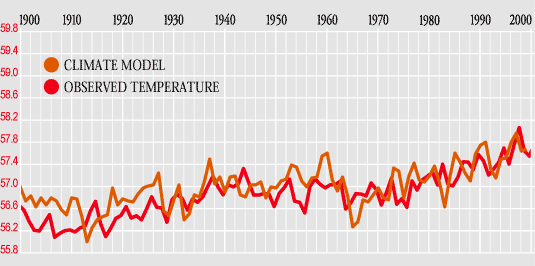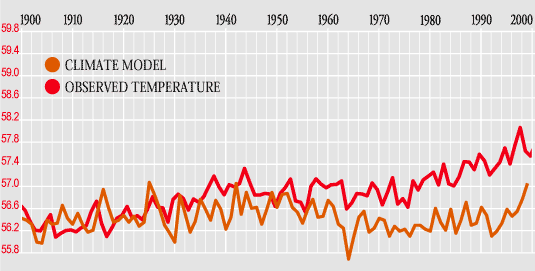Climate change scepticism is politically motivated, the evidence is all around us. Good science is about dispelling common prejudice, not taking leave of common sense. Dr. Mae-Wan Ho
There is little doubt that global warming is happening and happening fast (Abrupt climate change happening, SiS 20) [1]. But the public may have been distracted by the disproportionate attention the mainstream press has been giving to ‘sceptics’ of climate change. Their most recent effort in April 2006 was billed as an open letter signed by “more than 60 leading international climate change experts” [2] and addressed to Canada’s new Conservative Prime Minister praising his commitment to review the Kyoto protocol on reducing emissions.
Climate change sceptics are having a field day in the United States where a powerful anti-science lobby has effectively taken over science policy on a whole range of issues including climate change.
The US Congress asked the National Academy of Sciences (NAS) to report on the controversy surrounding the papers published in the late 1990s by climate scientists Michael Mann and colleagues [3] who concluded that the warming in the Northern Hemisphere in the last decades of the 20th century was unprecedented in the past thousand years.
In June 2006, the NAS released a report on the new study [4], concluding that the “recent warmth is unprecedented for at least the last 400 years and potentially the last several millennia”, and “supports the conclusion that human activities are responsible for much of the recent warming.”
I don’t really think they could have concluded otherwise.
We don’t have to accept the authority of the NAS. Just look at the latest evidence, which has been making headlines in the popular media over the past months. Not only is the land surface of the earth getting warmer, the seas are getting warmer especially at the poles, which is why the polar ice caps are melting rapidly.
Scientists from the British Antarctic Survey (BAS) report that over the past 50 years more than 13 000 sq km of sea ice in the Antarctic Peninsula has been lost. Melting in the Antarctic Peninsula removes sea ice that held back the movement of glaciers. As a result, glaciers flow into the ocean up to 6 times faster than before [5]. West Antarctica is also affected where the warmer seawater appears to be eroding the ice from below.
In 2001, the Intergovernmental Panel on Climate Change predicted that the average global sea level would rise by between 11 cm and 77 cm by 2100, but forecast that Antarctic’s contribution would be small. Within the past five years, however, studies found that melting Antarctic ice caps contribute at least 15 percent to the current global sea level rise of 2 mm a year. Several major sections of Antarctic ice have broken off in the past decade. The Larsen A ice shelf of 1 600 sq km broke off in 1995. The Wilkins ice shelf of 1 100 sq km fell off in 1998, and the 13 500 sq km Larsen B dropped away in 2002.
The major contributions to sea level rise from melting icecaps come from the Arctic, where the evidence is even grimmer. Two studies that combine computer modelling with paleoclimate records show that by 2100, the Arctic may increase in temperature 3-5C and become as warm as 130 000 years ago when sea levels eventually rose up to 6 m higher than today [6]. Bette Otto-Bliesnes at the National Center for Atmospheric Research (NCAR) and Jonathan Overpeck at University of Arizona in the United States reported their results in the March 24 issue of Science. The studies are based on data from ancient coral reefs, ice cores and other natural climate records as well as output from NCAR-based Community Climate System Model for simulating past, present and future climates.
What causes global warming is known as the greenhouse effect, a well-understood phenomenon in physics and chemistry [7]. The greenhouse effect is actually very important for making Earth just the right temperature for life, as opposed to Venus, which is too hot (450 C), and Mars (-53 C), too cold; the distance from the sun doesn’t quite explain that.
Instead, it is the earth’s atmosphere, which turns out to be the right thickness to act like cosy duvet, trapping sufficient solar energy to keep it warm and pleasant. The duvet is really a collection of gases in the atmosphere called greenhouse gases, because that’s what the glass wall of a greenhouse does. The major greenhouse gases are water vapour, carbon dioxide, methane and nitrous oxide.
Sunlight consists of electromagnetic radiation of wavelengths from 20 microns at the far infrared end to 200 nanometres at the far ultraviolet end. Various gases absorb light in the ultraviolet and infrared regions, but are transparent to visible light between 400 – 700 nm. Some of light is reflected from clouds and the land surface, the rest is absorbed by land, water, and vegetation, transformed into heat, and re-radiated in the form of invisible infrared radiation. The greenhouse gases absorb the infrared radiation from the earth’s surface, and send heat in all directions, including back to the earth, like the glass of the greenhouse. But too much greenhouse effect and the earth will heat up.
Of the greenhouse gases in the atmosphere, carbon dioxide is the most abundant, and there is good evidence linking the concentration of carbon dioxide in the atmosphere to the earth’s temperature [8, 9].
As recorded in ice cores from Vostok, Antarctica, the temperature near the South Pole has varied by more than 20 F (9.4 C) during the last 350 000 years. There have been peaks of warmth approximately every 100 000 years. The temperature and the carbon dioxide concentration closely track each other. The same close correlation occurs between temperature and methane concentration. Note that the temperatures at any one location, especially at the poles, will tend to go up and down much more than the average temperature of the earth.
Since the 1900s, the global average temperature and atmospheric carbon dioxide concentration have increased dramatically, and the two curves again closely coincide. The rapid rise in both surface temperature and carbon dioxide is one of the indications that humans are responsible for at least some of this unusual warming: the excessive use of fossil fuels, cement manufacture, chopping down forests, intensive agriculture, industrialisation and massive species extinctions.
Global warming is not just an increase in temperature; it is a conglomerate of correlated physical, ecological and social changes caused by decades of unsustainable use of the earth’s resources. This is fuelled by the dominant neo-liberal economic model of unrestrained growth, exacerbated by globalisation, which has resulted in the over exploitation of both environmental resources and people, impoverishing billions in historically the most resource-rich countries of the Third World (Sustainable world – a global initiative; Agriculture without farmers; Sustainable food system for sustainable development; Global food trade & the new slave labour)[10-13]. There are increasingly vocal demands for corporate responsibility and accountability. But those who wish to really make poverty history must address the causes at the very source: the dominant model that is responsible for both climate change and poverty.
To see if the effects on climate change due to human activities can be distinguished from those naturally occurring before humans beings had substantial impact, one of the best available computer models was rerun with inputs from both natural causes such as the change in luminosity of the sun, volcanic eruptions that send lots of dust and carbon dioxide into the atmosphere and slight changes in the earth’s orbit. The model with combined natural and human activities does track the warming trend in the past 100 years rather closely [9] (Fig. 1).
However, when human activities are left out, the model failed to capture the trend in actual data showing an increase in temperature especially since the 1950s. It clearly demonstrates that human activities have contributed significantly to global warming. It also suggests, by the same token, that our species can make a difference by changing our activities.


Figure 1. Climate model fit observations only when human activities are included. Upper graph emissions from human activities included, lower graph, emissions from human activities excluded
There is really nothing special about scientific evidence as opposed to any other evidence. One has to use critical judgement and good common sense to find coherence in the observations. It is like solving a murder mystery; we can piece the evidence together to get at what really happened.
Good science, in my book, is reliable knowledge of nature that enables us to live sustainably with her; it is not contrary to good common sense. The dominant science that glorifies competition, in contrast, has failed to satisfy the criteria of good science, and has failed the reality test in the word, as it has in science, as I argued in my books, Genetic Engineering Dream or Nightmare [14] and Living with the Fluid Genome [15].
Prof. Lewis Wolpert at University College London has done great damage to science by claiming science is against common sense. Science is not against common sense; it is against common prejudice. Science is systematic investigation and analysis that enables people to dispel common prejudice and restore good common sense. A lot of scepticism on climate change is linked to vested economic interests in business as usual, so we should be immediately sceptical about what the climate change sceptics say.
At a deeper level, however, it is a mistaken belief in Darwinian competition, in the ‘fittest’ growing ever bigger at the expense of all others. Richard Dawkins at Oxford University and other apologists of neo-Darwinism are flourishing at the London School of Economics, together with the mainstream neo-liberal economists, who too, believe in unsustainable growth by unfettered competition in the so-called free-market. That’s common prejudice for you. The real natural world, including most human societies, does not operate on the survival of the fittest as much as mutualism and reciprocity, and when we put that into practice, we may just be able to beat climate change (Dream Farm II, How to beat climate change and post fossil-fuel economy, SiS 29) [16].
Article first published 18/07/06
Got something to say about this page? Comment